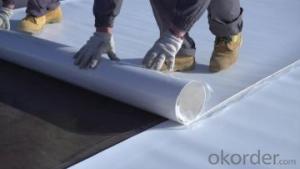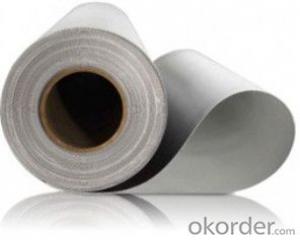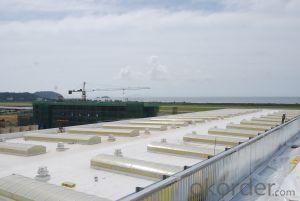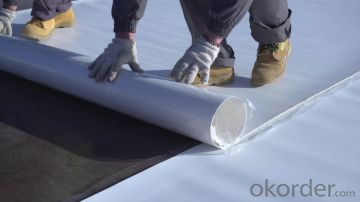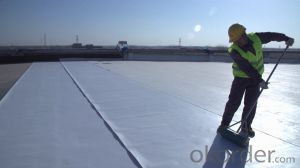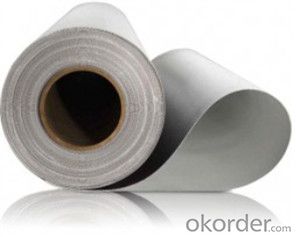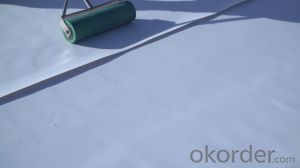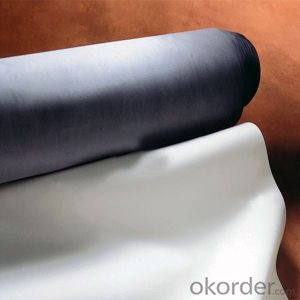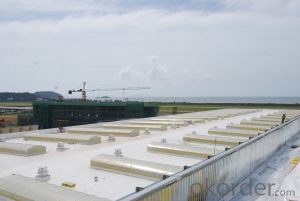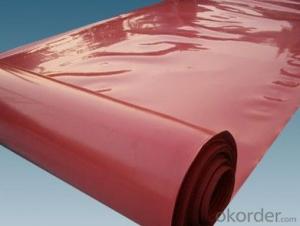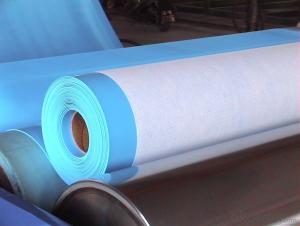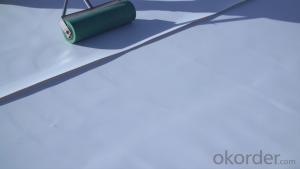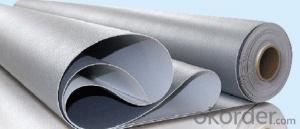Self Adhesive TPO Membrane Single-ply Roofing System
- Loading Port:
- Shanghai
- Payment Terms:
- TT or LC
- Min Order Qty:
- 4000 m²
- Supply Capability:
- 400000 m²/month
OKorder Service Pledge
OKorder Financial Service
You Might Also Like
Self Adhesive TPO Membrane
Product Profle of Self Adhesive TPO Membrane
TPO membrane is a flexible Thermoplastic Polyolefin (FPO) roofing membrane made from the incorporation of a ethylene propylene rubber into a polypropylene matrix. The membrane is specifically formulated for long-term weather resistance without plasticizers.
We produce 4 types of TPO membrane to satisfy all the needs of different applications.
1.Polyester Fleece Backing Thermoplastic Polyolefin Waterproof Membrane
2.Polyester Mesh Reinforced Thermoplastic Polyolefin Waterproof Membrane
3. Homogeneous Thermoplastic Polyolefin Waterproof Membrane
4. Self Adhesive TPO Membrane
Self Adhesive TPO membrane is TPO with self adhesive function. It's easy for installation, saving time and cost, especially labour cost.
Advantages of Self Adhesive TPO Membrane
-Self adhesive TPO membrane is easy for installation, saving time and cost, especially labour cost.
-TPO membrane can be overlapped and hot-air welded, offers exceptionally strong seam.
-Long-term weatherability, excellent durability, the service life of TPO is more than 50 years.
-High solar reflective, energy saving, environmental friendly.
-Excellent durability and root resistance, can be used as root barrier for green roof.
-Excellent the same low temperature resistance as rubber materials which can keep flexible at -40℃.
-Excellent chemical resistance to acids, alkali and salts.
-Available in more than 9 colors.
Applications of Self Adhesive TPO Membrane
-Various roofing waterproof projects, such as industrial and civil buildings, public constructions
- Full adhered system for concrete substrate or mechanically attached systems or ballasted system.
Propoties of Self Adhesive TPO Membrane
Item | Requirement | Test Method | ||
Thickness, min, mm | Sheet-overall | ≥1.0 | ASTM D6878 | |
Coating over fabric or scrim, weathering side only | ≥0.305 | ASTM D751 | ||
Breaking strength, min, N | ≥976 | ASTM D751 | ||
Elongation at reinforcement break, min, % | ≥15 | ASTM D751 | ||
Tensile strength,min, N | ≥245 | ASTM D751 | ||
Brittleness point, max, °C | ≤-40 | ASTM D2137 | ||
Ozone resistance | no cracks | ASTM D1149 | ||
Properties after heat aging | Breaking strength, % min | ≥90 | ASTM D573 | |
Elongation at reinforcement break, % min | ≥90 | ASTM D573 | ||
Tearing strength, % min | ≥60 | ASTM D573 | ||
Weight change (mass), max % | ≤±1 | ASTM D573 | ||
Linear dimensional change, max, % | ≤±1 | ASTM D1204 | ||
Water absorption, max, mass % | ≤±3.0 | ASTM D471 | ||
Factory seam strength, min, N | ≥290 | ASTM D751 | ||
Weather resistance | Visual inspection | - | ||
Packaging of Self Adhesive TPO Membrane
Thickness | Roll Size | Rolls / Wooden Crate | Wooden Crate / 20’ Container |
1.2 mm | 15 m2 | 25 | 20~25 |
20 m2 | 25 | ||
30 m2 | 25 | ||
1.5 mm | 15 m2 | 25 | |
20 m2 | 25 | ||
30 m2 | 20 |
Above quantities are indicative only. We can produce it according to your demands.
Storage of Self Adhesive TPO Membrane
TPO material should be stored in well-ventilated place and avoid being exposed to the sun or rain. The temperature in stored places can not be higher than 45° C. It only can be put horizontally in five-level. It has to be avoided acid, alkali, oil and organic solvents. The shelf life is 1 year.
Transportation of Self Adhesive TPO Membrane
TPO material should avoid inclination or lateral drift during transportation. When necessary, covering with felted fabric.
Application System of Self Adhesive TPO Membrane
We not only provides TPO waterproofing membrane, but also dedicates to integrated roofing systems. TPO single ply roofing waterproof system includes mechanically attached roofing system, fully adhered roofing system and ballasted roofing system.
Application Methods of Self Adhesive TPO Membrane
● For Mechanically Attached Roofing System
Before application, spread TPO membranes on substrate in advance. Install TPO membranes perpendicular to steel deck ribs on the substrate without distortions according to the flange. The overlapping width is 120 mm. The minimum overlapping distance of membrane short side direction is 50 mm. Fasteners are installed according to designed position. Hot-air welding is adopted for laps with 40 mm welding width.
● For Fully Adhered Roofing System
Before application, spread TPO membranes on substrate in advance. Install TPO membranes on the substrate without distortions according to the flange. The overlapping width should be more than 50 mm. Hot-air welding is adopted for laps with 40 mm welding width. Professional adhesives need to be used on both underside and substrate surfaces to adhere and maintain.
● For Ballasted Roofing System
Before application, spread TPO membranes on substrate in advance. Install TPO membranes on the substrate without distortions according to the flange. The overlapping width should be more than 50 mm. Hot-air welding is adopted for laps with 40 mm welding width.
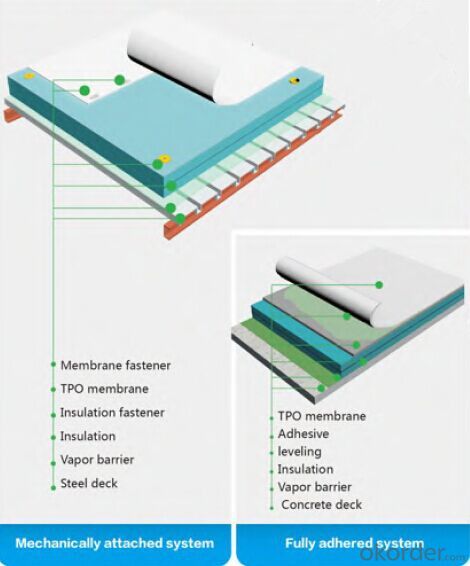
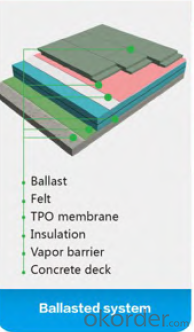
Attentions
● TPO membranes reflect heat and light, wearing protective clothing (long-sleeved shirt, long-barreled trousers), and wearing a filter to protect the skin and eyes from UV-induced damage.
● Security measures for roof perimeter are necessary when application. Sheet surface is slippery when wet, taking care to avoid slide.
● Sealants and adhesives are flammable containing solvents. They will be dangerous when exposure to heat, even have the possibility to catch fire and explode.
● Sealants, adhesives, cleaners should be avoided contacting with skin and eyes.
● No smoking during application.
FAQ
1. What’s your production ability of TPO membrane per year?
We own the largest EPDM production line in China. Our product ability of TPO membrane reaches 500million square meters.
2. How's your products quality?
Our TPO is with the top quality at home and abroad. Our quality is much higher than Chinese standard, they can satisfy the certification of CE, GOST-R, FM.
3. What's the service life of your TPO membrane?
The service life of our TPO membrane is more than 50 years.
4.What's your MOQ?
Our MOQ is 4000M2.
5. Can you provide free of charge samples for testing quality?
Yes, we’re very glad to send you free of charge samples for checking. You just need to pay for the freight cost.
6. How do you protect TPO membrane in transportation?
We package TPO rolls by PE bag, then 20~25 rolls will be packed into one big wooden crate.
7. Can you customize TPO membrane?
Yes, we’re very glad to customize TPO membrane according to your requirement. We can do more than 9 colors, and customize the thickness and width according to your requirement.
Photos
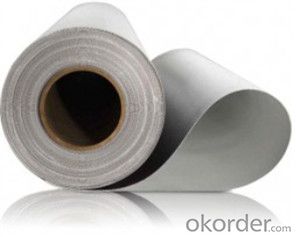
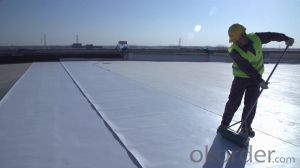
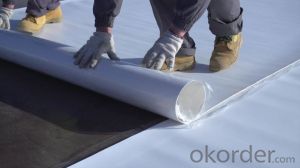
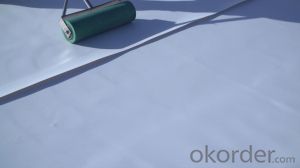

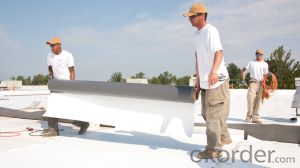
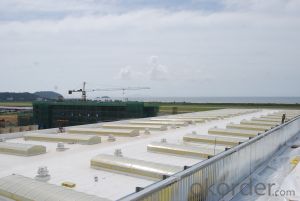
- Q: Can a waterproofing membrane be used in areas with high humidity?
- Yes, a waterproofing membrane can be used in areas with high humidity. The membrane is designed to prevent water penetration, including moisture from high humidity levels. It acts as a barrier, protecting the underlying surfaces from water damage, mold, and mildew.
- Q: 1.2 thick synthetic polymer waterproofing membrane two weight how to count
- Different materials of the coil its unit weight is not the same, and some polymer membrane with self-adhesive or empty shop, without adhesive, so according to the specific material and paste method for calculation, the above calculation, the exact calculation can be based on the actual The material was measured for its weight per unit weight and then the lap coefficient and binder were calculated.
- Q: Can a waterproofing membrane be used on gypsum board surfaces?
- Yes, a waterproofing membrane can be used on gypsum board surfaces. This membrane helps to protect the gypsum board from moisture, preventing water damage and increasing its lifespan.
- Q: Can a waterproofing membrane be installed on vertical surfaces without sagging or slumping?
- Yes, a waterproofing membrane can be installed on vertical surfaces without sagging or slumping. There are specific waterproofing membranes available in the market that are designed to adhere to vertical surfaces and maintain their shape and integrity. These membranes are typically made of materials that have a higher viscosity, allowing them to stick to the vertical surface and resist sagging or slumping. Additionally, some membranes may also have reinforced layers or mesh embedded within them to provide extra support and prevent sagging or slumping. Proper installation techniques, such as ensuring a clean and dry surface, using appropriate adhesives, and following manufacturer guidelines, are also crucial in ensuring that the waterproofing membrane adheres properly and does not sag or slump.
- Q: Can waterproofing membranes be used on mechanical rooms?
- Yes, waterproofing membranes can be used on mechanical rooms. Mechanical rooms often house equipment such as boilers, pumps, and ventilation systems, which can be sensitive to water damage. Waterproofing membranes provide a protective barrier against water infiltration and can help prevent leaks, moisture buildup, and potential damage to the equipment. Additionally, these membranes can also provide thermal insulation, noise reduction, and fire resistance properties. It is important to choose the appropriate type of waterproofing membrane based on the specific needs and requirements of the mechanical room.
- Q: Can a waterproofing membrane be applied on top of existing coatings?
- Yes, it is possible to apply a waterproofing membrane on top of existing coatings. However, there are certain factors that need to be considered before doing so. Firstly, the condition and adherence of the existing coating should be assessed to ensure it is in good condition and capable of providing a suitable substrate for the waterproofing membrane. If the existing coating is loose, damaged, or incompatible with the waterproofing membrane, it may need to be removed or repaired before applying the membrane. Additionally, compatibility between the existing coating and the waterproofing membrane is crucial. Different types of coatings and membranes may not adhere well to each other, leading to poor performance or failure. It is important to consult the manufacturer's recommendations and seek professional advice to ensure compatibility between the existing coating and the chosen waterproofing membrane. Furthermore, proper surface preparation is essential for the successful application of a waterproofing membrane on top of existing coatings. The surface should be thoroughly cleaned, free from dirt, debris, and any loose or flaking coating. Additionally, any cracks, holes, or imperfections in the existing coating should be repaired before applying the membrane. In conclusion, while it is possible to apply a waterproofing membrane on top of existing coatings, it is crucial to assess the condition and adherence of the existing coating, ensure compatibility between the coating and membrane, and properly prepare the surface for successful application. Seeking professional advice and following manufacturer's recommendations are highly recommended to ensure the effectiveness and longevity of the waterproofing system.
- Q: Can waterproofing membranes be used on roofs?
- Yes, waterproofing membranes can be used on roofs. These membranes are designed to provide a barrier against water infiltration, protecting the roof structure and preventing leaks. They are commonly used in various types of roofs, including flat roofs, low-slope roofs, and even sloped roofs in certain cases. Waterproofing membranes offer excellent durability and flexibility, making them an effective solution for roof waterproofing.
- Q: Can a waterproofing membrane be used on precast copper surfaces?
- Yes, a waterproofing membrane can be used on precast copper surfaces. Waterproofing membranes are versatile and can be applied on a variety of surfaces, including copper. These membranes are designed to create a barrier that prevents water penetration and protects the underlying structure from moisture damage. When applied correctly, a waterproofing membrane can effectively seal precast copper surfaces, providing long-lasting protection against water intrusion. However, it is important to ensure that the membrane is compatible with copper and that proper surface preparation is done before application to ensure optimal adhesion and performance.
- Q: Can a waterproofing membrane be used for dams?
- A waterproofing membrane is suitable for dams, which are constructions designed to retain water and form reservoirs. It is of utmost importance to guarantee that these structures are impenetrable to water to avoid leakage and potential harm. In the construction of dams, it is typical to utilize waterproofing membranes as a safeguard against water infiltration, which could lead to erosion or compromise the structural integrity. These membranes are typically composed of resilient materials like rubber or reinforced PVC, engineered to withstand water pressure and endure over time. Furthermore, the installation of a waterproofing membrane also aids in mitigating the potential risk of seepage and leakage in the dam, ensuring the overall structure's safety and efficacy.
- Q: Can a waterproofing membrane be used on vinyl surfaces?
- Yes, a waterproofing membrane can be used on vinyl surfaces. The membrane serves as a protective layer that prevents water from penetrating and damaging the vinyl material.
Send your message to us
Self Adhesive TPO Membrane Single-ply Roofing System
- Loading Port:
- Shanghai
- Payment Terms:
- TT or LC
- Min Order Qty:
- 4000 m²
- Supply Capability:
- 400000 m²/month
OKorder Service Pledge
OKorder Financial Service
Similar products
Hot products
Hot Searches
Related keywords
